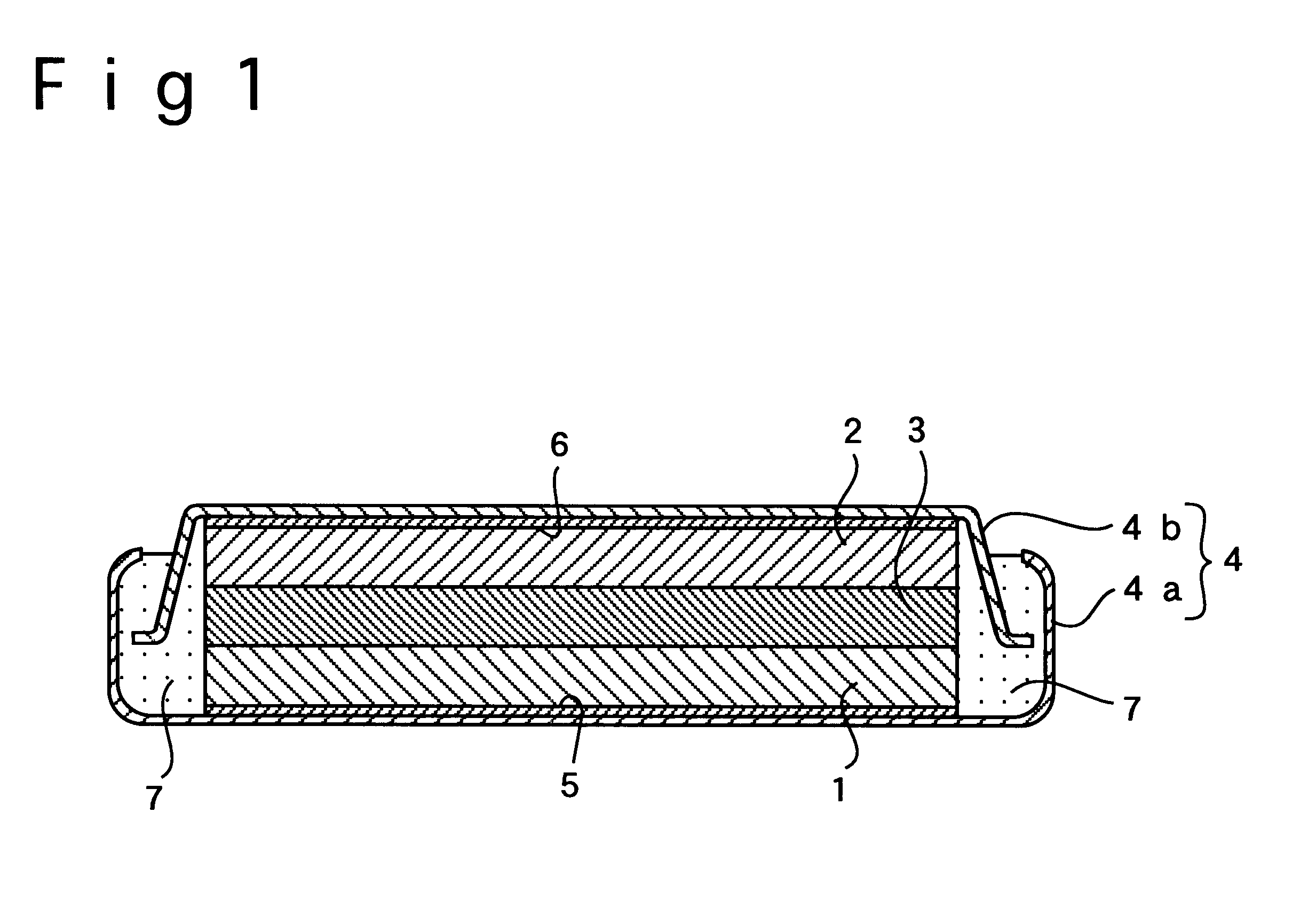Lithium battery with boron-containing lithium-manganese complex oxide cathode material
a lithium-manganese complex and cathode material technology, applied in the field of lithium-manganese complex oxide cathode material lithium battery, can solve the problems of battery degradation, battery crystal structure destruction, and battery degradation,
- Summary
- Abstract
- Description
- Claims
- Application Information
AI Technical Summary
Benefits of technology
Problems solved by technology
Method used
Image
Examples
examples 2 , 3
Examples 2, 3
Examples 2, 3 were different from Example 1 only in the type of solute used for the nonaqueous electrolyte. As shown in Table 1 below, Example 2 used lithium pentafluoroethanesulfonimide LiN(C.sub.2 F.sub.5 SO.sub.2).sub.2 whereas Example 3 used lithium trifluoromethanesulfonmethide LiC(CF.sub.3 SO.sub.2).sub.3. Except for this, the same procedure as in Example 1 was taken to fabricate the respective lithium batteries of Examples 2 and 3.
examples 4 to 7
Examples 4 to 7 were different from Example 1 in that the positive-electrode active materials of boron-containing lithium-manganese complex oxides were prepared using lithium hydroxide LiOH, boron oxide B.sub.2 O.sub.3 and manganese dioxide MnO.sub.2 in varied mixing ratios. As shown in Table 2 below, Example 4 blended these ingredients in an atomic ratio (Li:B:Mn) of 0.505:0.01:1; Example 5 blended them at an atomic ratio of 0.51:0.02:1; Example 6 blended them at an atomic ratio of 0.55:0.10:1; and Example 7 blended them at an atomic ratio of 0.60:0.20:1. Except for this, the same procedure as in Example 1 was taken to fabricate the respective positive electrodes. Incidentally, all the resultant boron-containing lithium-manganese complex oxides presented the mean manganese valence of 3.80, similarly to that of Example 1.
Using the resultant positive electrodes, lithium batteries of Examples 4 to 7 were fabricated the same way as in Example 1.
examples 8 to 19
Examples 8 to 19 were different from Example 1 only in the type of solvent used for the nonaqueous electrolyte. As shown in Table 3 below, Example 8 used a solvent mixture of ethylene carbonate (EC) and 1,2-dimethoxyethane (DME); Example 9 used a solvent mixture of butylene carbonate (BC) and 1,2-dimethoxyethane (DME); Example 10 used a solvent mixture of vinylene carbonate (VC) and 1,2-dimethoxyethane (DME); Example 11 used a solvent mixture of .gamma.-butyrolactone (.gamma.-BL) and 1,2-dimethoxyethane (DME); Example 12 used a solvent mixture of sulfolane (SL) and 1,2-dimethoxyethane (DME); Example 13 used a solvent mixture of propylene carbonate (PC) and 1,2-diethoxyethane (DEE); Example 14 used a solvent mixture of propylene carbonate (PC) and 1,2-ethoxymethoxyethane (EME); Example 15 used a solvent mixture of propylene carbonate (PC) and tetrahydrofuran (THF); Example used 16 a solvent mixture of propylene carbonate (PC) and dioxolane (DOXL); Example 17 used a solvent mixture of...
PUM
| Property | Measurement | Unit |
|---|---|---|
| temperatures | aaaaa | aaaaa |
| temperatures | aaaaa | aaaaa |
| temperatures | aaaaa | aaaaa |
Abstract
Description
Claims
Application Information
 Login to View More
Login to View More - R&D
- Intellectual Property
- Life Sciences
- Materials
- Tech Scout
- Unparalleled Data Quality
- Higher Quality Content
- 60% Fewer Hallucinations
Browse by: Latest US Patents, China's latest patents, Technical Efficacy Thesaurus, Application Domain, Technology Topic, Popular Technical Reports.
© 2025 PatSnap. All rights reserved.Legal|Privacy policy|Modern Slavery Act Transparency Statement|Sitemap|About US| Contact US: help@patsnap.com

